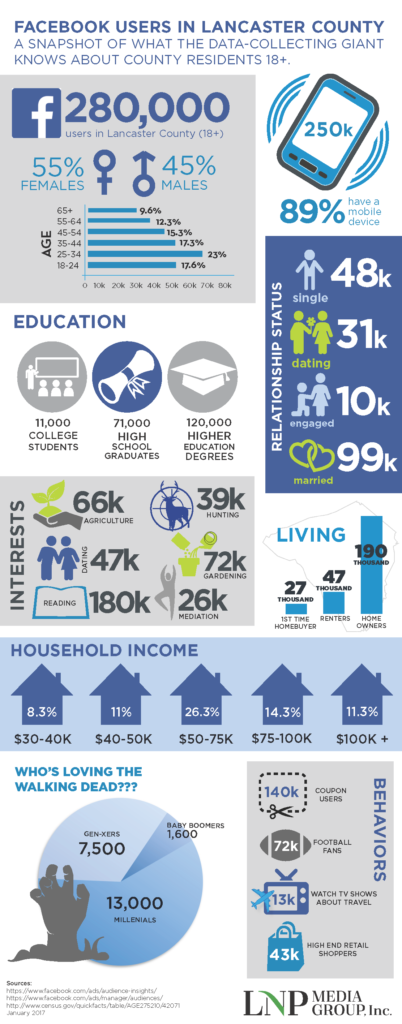
Video Production in Lancaster PA
If you have a small to medium sized business in Lancaster County PA, or in surrounding counties such as Berks, Dauphin, Chester, York, or Lebanon, you may wonder how to secure high-quality videos for your company’s marketing campaigns. Lancaster is not a large metro area like Philadelphia but it’s still very possible to find affordable video marketing services locally. This guide will walk you through three topics:
1. How to find a local video production agency.
2. What to expect during the video production process.
3. Ways you can leverage video in your marketing.
Step 1 – Find the right Lancaster video production company for your business’s needs
To find a video production company that suits your needs, first develop an initial list of requirements for your video project. Your list may evolve after you have found a video production company, but you need to have a starting place.
Here are some considerations for your initial list of requirements:
- • Video length: A commonly used video length is a 15 to 30 second spot for pre-roll ads, TV ads, or social media. Another common length is a 2 to 3 minute video for branding or how-to instruction. Of course, videos can be much longer as well. You’ll need to think about where your video will be distributed (see below) and the content of your video.
- • Distribution: Consider where your video will be distributed, for example, on your website, TV, OTT/CTV, Social Media platforms (Facebook, Twitter, YouTube, Vimeo, LinkedIn, TikTok, etc). If you want your video to be placed as a pre-roll ad, then you’ll need the services of a digital marketing agency. In this case, working with a video production team that is part of a digital agency will save you time and effort.
- • Topic: The options for video topics are almost limitless, but here are some common examples: a history or narrative of your company and its brand, a short advertising spot to entice customers to buy a product or service, a how-to video about using your products or services, a training video for onboarding new hires, or a testimonial video from customers who are your company’s fans.
- • Style: Will the video be taken in a single shot? Or will there be multiple shots that are edited together? Will sound need to be recorded, or will there be music or voice-over added in post-production? Do you need actors? Do you need animation or drone footage? Animation and drone piloting are a very specific skills that not all video companies can provide. Drone pilots are required to be certified and the drone itself must be registered with the FAA. In Pennsylvania, drone pilots need to abide by regulations including no-drone zones, altitude restrictions, no surveillance, and more. So if drone footage is a requirement, make sure to find a video production company that has a properly licensed drone pilot.
- • Location: Videos can be shot on-site or in the studio. Not all video production companies have their own studio, so if you want your video shot in a studio, you’ll need to inquire about facilities. An on-site video could be shot at your location or at another location such as where your products are services are being used. Because video production companies will need to charge for their travel time to the site, in-studio videos are more affordable than on-site videos.
- • Budget: Video is an incredibly valuable format for conveying your business’s marketing message in a way that is engaging and accessible. An inexpensive video can cost as little as $500 for a 30 second promo filmed in the studio. A longer affordable video format is two to three minutes that are filmed on-site at a cost of $3,500 to $5,000. These price points are reasonable given the skills and equipment required for the production of high quality videos. Of course, videos can cost much more if they are longer and more complex.
Now that you have your list of requirements, how do you go about finding a local Lancaster County video company? Here are some ideas to help you with your search:
- • References: Ask colleagues in your field if they have had videos made by a local Lancaster video production company. Make sure to ask if they were happy with the work and if they have advice for your video project.
- • Browse your competition: Take a look at competitors’ websites and marketing campaigns. Do they use video and, if so, do you like what you see? A quick call to the competitor may provide you with information on who produced their videos. The value of using a video production company that has worked for a competitor is that the video team will already be familiar with the types of products and services your company offers.
- • Search engines: Use Google or your favorite search engine to find local video production companies. Use several different search terms to develop different lists of video production companies. Remember to look past the first page of search results; hidden gems can be found further down the list. Use search terms that include your location, such as “Lancaster County PA video production”, in order to find the most relevant companies. You’ll see ads on search results pages too and some of these may be worth checking out.
- • Review samples: Video production companies should have samples of their work included on their websites. Take a look at those samples and see if the style and content match up with your needs.
Step 2 – What to expect in the video production process
You’ve found your ideal video production agency and you are ready to start work. What does the video production process look like? This handy guide breaks down the steps, so that you’ll have an idea of what to expect as you get started.
PLANNING
The first phase, naturally, is the planning phase. You should expect to meet with your video agency team members to discuss key points such as:
- • Audience Profile: The video team will need to know the audience you are trying to reach. The first question will be whether you are trying to reach consumers (B2C) or businesses (B2B). If you are trying to reach consumers, who are they? Retirees? Young parents? Home repair do-it-yourselfers? Fashionistas? If your video will be viewed by other businesses, who are they? Firms in need of legal advice? Companies that need construction services? Manufacturers who need safety compliance consulting? Knowing the audience will help your video team point the project in the right direction.
- • Brand position: In addition to defining your audience you also need to define your brand. Is your brand identity young and edgy? Is it down-home and comfortable? Does your brand identity include professional certifications or expertise? Is your brand a market leader or an underdog? Is your brand a bargain or a luxury? And, is your brand satisfied with its current position or does your brand need to develop a new identity? Answers to these questions will help the video team understand the tone they need to achieve in your video.
- • Content Development: Once you have defined the audience and your brand position, you can brainstorm the content of the video. You’ll work with the video team to decide what will be shot and where, as well as the number of shots and how they would need to be threaded together. You’ll decide if there will be people in the video and, if so, who they are. If you’ll be filming people speaking, then you’ll need to have scripts written; your video team will be able to help with this. You’ll also make choices regarding voice-overs, background music, special effects, drone footage, and text on screen. Your finished video will need to be framed with an intro shot and an exit shot, or possibly an exit screen that has written messaging such as your business’s logo, web address or phone number.
- • Storyboarding: Once all of the content decisions have been made, the video agency team will create a storyboard. A storyboard is a visual, graphical plan, shot by shot, of how your video will flow. The storyboard proceeds in a linear fashion from intro to end with notes about the action, the script, and production. Once the first draft of your storyboard is completed, consider sharing it with members of your team to get their input before shooting starts. A well-developed storyboard will make production faster and will help avoid costly re-shoots.
- • Production Planning: After the storyboard has been finalized, you will be ready to make a production plan. This plan will include all the details for the shoot, such as dates, times, locations, equipment, props, scripts, and persons. If you are planning an outdoor shoot, you’ll need to consider the time of day/angle of the sun, so as to get the best opportunity for good natural lighting. You’ll also need to plan for rain dates in case of inclement weather.
PRODUCTION
Once planning is complete the next phase is production. With your storyboard and production plan in place, production should proceed smoothly and includes the following elements:
- • On-site or in-studio shooting: Shooting on-site involves the video team and their equipment traveling to the specified location for the shoot. To save time, ensure that you have the site all set up and ready for the video team’s arrival. Conversely, shooting in the studio means that you’ll need to transport all of your people and items on the designated time/place.
- • Directing and filming: Your video production team will direct the action as they film it. Having an experienced team directing the action ensures that the storyboard is followed, so that the end product is what was planned. An experienced director will also help navigate any unforeseen last-minute changes that might occur, such as missing props, missing actors, or a cloudy day.
- • Photography: Consider contracting with your video production agency to have still photographs taken at the same time as the video is being filmed. Still shots can be used on your website, social media, or in ads. Still photographs will be an additional expense because a photographer will need to take the shots while the videographer does the filming. However, if you’ve gone to all the effort of setting up a great plan and a great setup for a video, having still photographs taken at the same time will maximize the value you’ll receive from your efforts.
- • Lighting and sound: Your Lancaster video agency will bring appropriate lighting and sound equipment with them, according to the needs outlined in the storyboard and production plan. Professional lighting and sound equipment are essential to producing a high-quality video. You may think you can produce a video yourself just using your iPhone, but there is no comparison of visual and audio quality from an iPhone vs. professional equipment. A top quality video is a long-term investment in your business.
- • Set design and styling: The video team members will also be able to guide you in the design of the set and overall styling. Styling includes the selection, placement and usage of items such as props, costumes, hair, and makeup. Props can be as simple as notepads, laptops, and coffee cups for a conference room video shoot. Or, they can be as complex as having the right vehicles in the background, or pouring the perfect mug of beer. All of these elements need to be aligned with your brand position and intended audience in order for your video to be a success.
POST-PRODUCTION
The video shoot has been completed and now it’s on to post-production. This phase will take your video agency a week or more to complete and involves the following aspects:
- • Professional Editing: Your video production team will have more footage than needed for the length of your final video. All of the footage needs to be reviewed and the best footage selected for inclusion in your video. Video footage will be rearranged to match the sequence dictated by the storyboard and transitions will be created between clips. Color corrections, filters, and other enhancements will be applied as needed.
- • Voice over: If voice over is part of your video, it will generally be during the post-production phase using a professional voice actor. Your video team should be able to provide a resource for voice overs. Once the voice over is recorded, the video production team will sync the voice over to the video, so that they work together seamlessly.
- • Music: Your video team will be able to guide you with regard to music that is legally allowed to be used in your video. Most music is copyrighted, so you can’t just put your favorite songs as background to the video. The video production team should have access to a library of stock background music, much like stock images. However, this music may have a generic feel that is not the right mood for your video. If that is the case, discuss with the video production team if it’s possible to acquire a license to use a copyrighted piece of music. Another alternative is to work with a local Lancaster County musician who would like to sell their music, or perhaps allow you to use for free it in exchange for a credit at the end of the video.
- • Graphics and animation: If your video production team is part of a digital agency, they will have artists who can design graphics and slides for your video. Animation is a much more difficult skill to find in the Lancaster area. Animation also tends to be expensive, so discuss this with your video production team to decide if it is truly essential to your project.
- • Color grading: Color correction, mentioned earlier, involves ensuring that the color in the video matches what was naturally present during filming. Color grading is different and is a creative effort to apply color to create a mood or effect. Your video may or may not need color grading, depending on the goal of your video.
Step 3 – Ways to leverage video in your marketing.
Your video is complete and it’s perfect! But how do you get it in front of your target audience? Ideally, the video production team you selected will be part of a Lancaster digital agency. A local digital agency has the expertise to consult with you to find the most targeted and effective digital channels to distribute your new video. Examples of possible channels include the following:
- • Websites/Blogs: If your video is a branding or testimonial video, posting it on your own website or blog page is a logical choice. Videos on your site are useful for two main reasons. First, video is an easy way for users to learn about your brand, service, and products. Watching videos quickly conveys information in an engaging fashion that text can’t match. Second, Google favors video content, so posting videos can help with your site’s search engine optimization (SEO). However, to ensure best results from having a video on your site make sure you follow all of Google’s best practices when posting your video.
- • Social media channels: 15 or 30 second videos are perfect to use in social media. You can post your videos on your social media channels organically or you can get extra value out of your video investment through a paid social media marketing campaign. Facebook and other social media platforms like Instagram, Snapchat, and Twitter provide options for targeting your desired audience by demographics, hobbies, location, behaviors, and more. Your Lancaster County digital marketing agency will help you with targeting selections, copy-writing, and ad creatives. A local digital agency will also report on campaign performance and will optimize the campaign as needed. Read our social media marketing blog post here:
- • Targeted emails: Email marketing is another digital campaign type that has many options for audience targeting including location, interest, business category, occupation and more. Video can be embedded within the email body, or the email can contain a link to a web page with the video. Embedding video is a great user experience on most email clients, with the exception of Outlook, which does not support video players. Read our blog post on email marketing here.
- • TV, OTT, and CTV commercials: TV, OTT and CTV are prime placements for your new video. CTV pre-roll ads allow you to reach people who like to stream content but don’t use cable. OTT ads also reach people who don’t use cable, but have the advantage of being clickable and viewable on phones and tablets. TV, of course, is the traditional video ad channel. All three formats provide targeting options including by day part. Read our blog post primer on OTT and CTV here.
- • Pre-roll and post-roll: If your video is a 15 to 30 second ad spot, pre-roll and post-roll offer a wealth of placement and targeting possibilities. Your pre-roll/post-roll video ad can be distributed via Google Ads or Youtube and targeted by demographics, interests, affinities, custom intent, and more. Remarketing is an option that will allow your video to be shown to audiences who have previously engaged with your videos. Video pre-roll ads can also be placed on local news media websites that have news videos, such as LancasterOnline. When video is placed as a pre-roll ad on local news videos, you can select the type of video content that you want your pre-roll ad to be associated with. Placement on a local news media site ensures that your video is associated with trusted local news content.
According to Forbes magazine, the use of video for small and medium sized businesses can be summed up in four broad categories. First, it increases social engagement, second, it works well on mobile, third, it boosts SEO on your site, and fourth, it conveys brand personality. All of these reasons, and more, make a compelling argument for investing in video for your local Lancaster business.
LNP Media group is a full service digital agency and video production company. We have an in-house video production staff with years of experience crafting the stories of companies in the Harrisburg-Lancaster-Lebanon-York area and beyond. We have a certified drone pilot, a state-of-the-art video studio, and full post-production editing capabilities. Once your video is complete, our digital agency team can place your video in a targeted digital campaign such as pre-roll, social media, email marketing, display, or more. Contact us today for a free video strategy session.


 Just like the competition athletes face on the field, your business has its own competition. By becoming a team sponsor, your business will attract the sports fans in Lancaster and beat out the competition. When fall comes around, high school football games attract fans that could also become customers. It’s not just men reading the Sports Section. Teachers, parents, students or any fan of local Lancaster high school football teams could be reading your advertisement in LNP. This opportunity allows you to connect with a wide range of sports enthusiasts. Your business could be seen by the 140,000 people who read LNP on weekdays when you become a part of the High School Football Preview.
Just like the competition athletes face on the field, your business has its own competition. By becoming a team sponsor, your business will attract the sports fans in Lancaster and beat out the competition. When fall comes around, high school football games attract fans that could also become customers. It’s not just men reading the Sports Section. Teachers, parents, students or any fan of local Lancaster high school football teams could be reading your advertisement in LNP. This opportunity allows you to connect with a wide range of sports enthusiasts. Your business could be seen by the 140,000 people who read LNP on weekdays when you become a part of the High School Football Preview. Maybe that’s why we were surprised when we started getting positive feedback. Sometimes it was a short note. Other times it was a legitimate, handwritten letter. (Yes, they still exist!) And we started getting emails, and Facebook posts and comments. We got lots of positive comments in surveys. In fact, everywhere we look, people were making an effort to tell us how much they like our new magazine. There’s no other way to describe it. Sunday magazine got rave reviews.
Maybe that’s why we were surprised when we started getting positive feedback. Sometimes it was a short note. Other times it was a legitimate, handwritten letter. (Yes, they still exist!) And we started getting emails, and Facebook posts and comments. We got lots of positive comments in surveys. In fact, everywhere we look, people were making an effort to tell us how much they like our new magazine. There’s no other way to describe it. Sunday magazine got rave reviews. Our last survey cinched it. 7 out of 10 people who subscribe to LNP on Sundays reported that they read Sunday magazine every week. That translates to loyal weekly readership in over 50,000 homes, with a readership of almost 140,000.
Our last survey cinched it. 7 out of 10 people who subscribe to LNP on Sundays reported that they read Sunday magazine every week. That translates to loyal weekly readership in over 50,000 homes, with a readership of almost 140,000.

